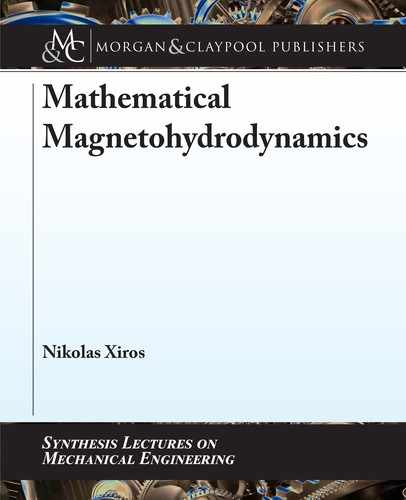
7.7. SECONDARY ELECTRON EMISSION 89
and results as
S
eff
D
j
i
0
st
j
n
S
0
C
0
1
d
C
0
j
i
st
: (7.26)
is demonstrates that the effective sticking of the neutrals does not only depend on the temper-
ature, but also on the ion flux. us, the transport of ions and neutrals can no longer be treated
independently when surface reactions are included.
e area of surface chemistry in plasma processing has been very little investigated so far,
so that a reliable modeling of reactive plasmas is hampered by the poor knowledge of surface
processes.
7.7 SECONDARY ELECTRON EMISSION
Upon ion impact on a solid surface, the electronic interaction may create free electrons which
are backtransmitted through the surface, the so-called secondary electrons. In analogy to the
sputtering yield, the secondary electron emission coefficient
e
(often called SEEC) is defined
as the flux of emitted electrons, j
se
, relative to the incident ion flux,
e
D
j
se
j
i
: (7.27)
Secondary electron emission occurs by a variety of mechanism, which are classified as potential
emission and kinetic emission.
In potential emission, the driving process is transfer of an electron from a surface atom
when a slow ion approaches a surface, similarly as demonstrated for the charge transfer collisions
in Section 2.6. Two selected atomic processes are shown in Fig. 7.16. During Auger neutraliza-
tion, an electron tunnels from an electronic state to the ground atomic state of the ion. If the
ionization energy of the atom, E
i
, is larger than 2ˆ where ˆ denotes the work function of the
solid, an electron can be emitted from the solid into the vacuum. During resonance neutraliza-
tion an electron below the Fermi level tunnels into an empty state of the ions. An electron from
the Fermi edge can fill the vacancy and transfer the released energy to another electron which is
emitted. Again, the condition is that the ionization energy of the excited atomic state is larger
than 2ˆ.
ere is no simple formalism describing the potential emission. Measurements can be
found in literature such as shown in Fig. 7.17 for the energy distribution of the secondary elec-
trons emitted during low-energy bombardment. At constant ion energy, both the yield and the
mean energy of the electrons increase with decreasing ion mass, due to the increasing ionization
energy. Estimating a total SEEC yield from Fig. 7.17 yields values between about 2:5 10
2
and 2:5 10
1
. A very rough empirical relation for clean metal surfaces is
e
D 0:016 .E
i
2ˆ/=eV: (7.28)
Potential emission is characteristic at ion energies from floating plasmas. However, it is
important to note that the potential emission of secondary electrons depends critically on the

90 7. PLASMA-SURFACE INTERACTION
Φ
E
i
E
i
Figure 7.16: Two possible processes of potential emission of secondary electrons: Auger neu-
tralization (left) and resonance neutralization (right).
15 eV He
+
, Ne
+
, Ar
+
, Kr
+
, Xe
+
→ W
clean
Xe
+
Ne
+
He
+
Kr
+
Ar
+
0 5 10 15 20
×10
-2
3
2
1
0
Electron Energy (eV)
dN / dE (electrons / ion ∙ eV)
Figure 7.17: Energy distribution of secondary electrons due to potential emission from a clean
tungsten surface, by different low energy ions.
surface state. Adsorbates on the surface, such as oxidation, may increase the SEEC significantly.
As standard plasma processes do not make use of UHV technology and the process gases do
normally not comply with extreme requirements of purity, the surface state during a plasma
process is mostly unknown, as it results from a balance of different chemical reactions and ion
induced processes as described above.
Kinetic emisson of secondary electrons is attributed to the creation of core vacancies in
surface or bulk atoms due to electronic collisions. Transitions from higher levels cause cascades

7.7. SECONDARY ELECTRON EMISSION 91
of Auger electrons. From the primary process, the SEEC is expected to be proportional to the
electronic stopping cross section. According to Section 7.1 for sufficiently low energies, it this
scales with the ion velocity
e
S
i
.E
0
/
p
E
0
: (7.29)
is is roughly confirmed in Fig. 7.18. In contrast to potential emission, the SEEC increases
with the ion mass due to increased electronic stopping. Kinetic emission becomes dominant
at energies well above 100 eV, so that it determines the SEEC in plasma-surface interaction
only with biased substrates. It is seen from Fig. 7.18 that also kinetic emission is significantly
influenced by surface impurities.
→ INCONEL 625
(o) - Oxidized
(c) - Clean
10
3
10
5
10
4
5.0
4.5
4.0
3.5
3.0
2.5
2.0
1.5
1.0
0.5
0
Incident Ion Energy E
0
(eV)
ϒi (electrons / ion)
O
+
(o)
O
+
(c)
He
+
(o)
He
+
(c)
H
+
(c)
H
2
+
(c)
H
2
+
(o)
H
+
(o)
Figure 7.18: SEEC by kinetic emission for different ions incident on a clean and an oxidized
surface of a nickel-based structural alloy.
..................Content has been hidden....................
You can't read the all page of ebook, please click here login for view all page.
